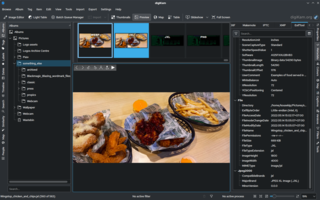Prerequisites
Format support
Since lossless data compression excludes the possibility of the introduction of padding, all lossless audio file formats are inherently gapless.
These lossy audio file formats have provisions for gapless encoding:
Some other formats do not officially support gapless encoding, but some implementations of encoders or decoders may handle gapless metadata.
- LAME-encoded MP3 can be gapless with players that support the LAME Mp3 info tag. [7]
- AAC in MP4 encoded with Nero Digital from Nero AG can be gapless with foobar2000, latest XMMS2, and iTunes 7.1.1.5 through 11.4.
- AAC in MP4 encoded with iTunes (current and previous versions) is gapless in iTunes 7.0 through 11.4, 2nd generation iPod nanos, all video-capable iPods with the latest firmware, and recent versions of foobar2000. [8] [ irrelevant citation ]
- iTunes-encoded MP3 is gapless when played back in iTunes 7.0 through 11.4, 2nd generation iPod nanos, and all video-capable iPods with the latest firmware.
- Windows Media Audio encoded with Windows Media Player 9 can be gapless with Windows Media Player 9 and onwards.
- Windows Media Audio encoded with Sound Player Lilith can be gapless with latest Sound Player Lilith onwards. [9]
- ATRAC on MiniDisc is gapless through the use of TOC (Table of Contents).
Player support
Optimal solutions:
Hardware
- Apple:
- iPod classic supports gapless playback of MP3s and AACs from the fifth generation onward [10]
- iPod nano second generation and later [10]
- iPod Touch [10]
- Archos Gmini XS202S
- Cowon S9 supports gapless playback without software dependency since 2.31b firmware. Most newer Cowon players support gapless playback right out of the box (J3, X7, iAudio 9)
- Linn Products DS network players
- All players in the Logitech/Slim Devices Squeezebox range support gapless playback for all gapless formats (lame MP3, FLAC, Vorbis, etc.). Crossfading is also optionally available.
- Microsoft Zune supports gapless playback with Zune 2.5 or later firmware, though some bugs remain and occasionally small pops or skips can be heard. [11]
- Panasonic RX-D55AEG-K, a portable radio recorder with CD player
- Rio Karma gapless hardware player with no software dependency (FLAC, Ogg, MP3, WMA), first portable DAP with the feature [12]
- Roberts Sound 48, a clock radio with CD player
- Rockbox for various digital audio players.
- Sony:
- MiniDisc Walkman supports gapless playback (including non-Sony Walkman MiniDisc players)
- CD Walkman (such as D-NE330) supports gapless playback of ATRAC-encoded CDs
- VAIO Pocket supports gapless playback (through a firmware update) of ATRAC files
- Network Walkman NW-HDx and NW-A (1x00, 3000, 60x, 80x) DAPs supports gapless playback of ATRAC files - after this Walkman DAPs lost the feature when ATRAC support ceased, but continued in Japan where players still came with ATRAC. Gapless playback returned outside Japan 5 years later with Walkman NWZ-F80x through the FLAC format. [13]
- Trekstor Vibes gapless hardware player with no software dependency
- Victor Alneo V Series and C Series [14] [15]
Software
- Amarok, for Linux [16]
- AIMP for windows
- Audacious, for Linux
- Banshee, for Linux
- Clementine, cross-platform.
- cmus, for Linux and BSD.
- Cog, for OS X
- DeaDBeeF, for Linux
- foobar2000, for Windows and Mac
- Groove Music, for Windows 10.
- iTunes 7.0 through 11.4 supported as default gapless playback on Macintosh and Windows without having to combine tracks during encoding (a limitation of previous releases). Some users in unusual situations have complained that the one-time analysis is a system-intensive process that can stall or crash computers.
- JRiver Media Center, for Windows
- KODI, for Windows, Linux, OS X, Android and others.
- mplayer2, for Linux, OS X, and Windows supports gapless playback of flac when used with option "-gapless-audio".
- mpv (media player) for BSD, Linux, macOS, Windows.
- MusicBee, for Windows
- Music On Console, for Linux and other Unix-like platforms.
- Music Player Daemon, for Linux and other Unix-like platforms.
- Plex, for all supported platforms either through the platform player or PlexAmp [17]
- Qlab, for OS X
- Quod Libet, multi-platform.
- Rhythmbox, for Linux
- Winamp, supports gapless playback for MP3, M4A/AAC, Ogg Vorbis and FLAC files (since version 5.3).
- Windows Media Player, has supported gapless ripping and playback of WMA since Windows Media 9. Available on all current Windows machines.
- XMPlay, supports gapless playback for all format files
Alternative or partial solutions:
- XMMS2 – has native support for gapless MP3 / Ogg Vorbis and FLAC










